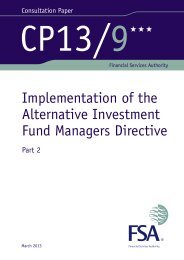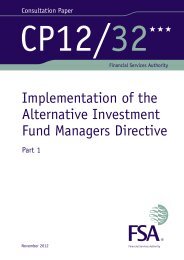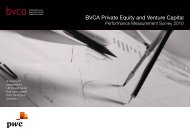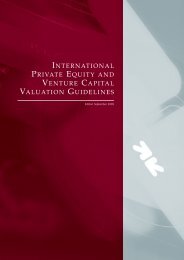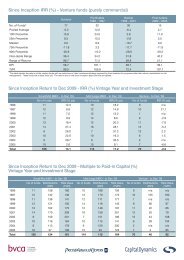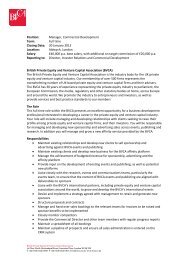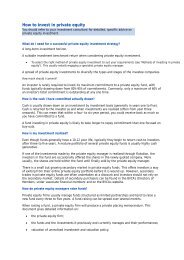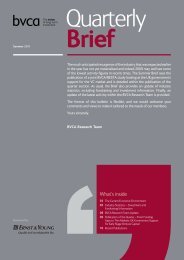A Guide to Private Equity - BVCA admin
A Guide to Private Equity - BVCA admin
A Guide to Private Equity - BVCA admin
You also want an ePaper? Increase the reach of your titles
YUMPU automatically turns print PDFs into web optimized ePapers that Google loves.
Vesting<br />
The private equity firm may require the shareholder founders or management or other key employees <strong>to</strong><br />
remain working with the company for a minimum term before they can realise the rights over all the options<br />
or all the shares ascribed <strong>to</strong> them. The shares are considered vested when an employee can leave his job,<br />
yet maintain ownership of the shares or exercise his options <strong>to</strong> obtain the shares with no consequences.<br />
Options<br />
The percentage of equity shares reserved for new options for existing and future employees should<br />
also be set out in the term sheet. This will affect the valuation of the company.<br />
Miles<strong>to</strong>nes<br />
Miles<strong>to</strong>nes are often used <strong>to</strong> set goals that the management team have <strong>to</strong> reach before additional<br />
tranches of capital are put in<strong>to</strong> the company by the inves<strong>to</strong>r, or management salaries reviewed or<br />
share options granted.<br />
Confidentiality<br />
The term sheet will contain a clause on confidentiality, ie. that both the inves<strong>to</strong>r and the founder /<br />
management team will keep the fact that discussions are progressing between them confidential as<br />
well as agreeing not <strong>to</strong> divulge any information supplied.<br />
Exclusivity<br />
The private equity firm may want <strong>to</strong> include an exclusivity clause in the term sheet preventing you from<br />
talking with other private equity firms about investing in your proposition for a specified period of time,<br />
usually the period that the various due diligence exercises are carried out.<br />
Fees<br />
The term sheet will set out the basis on which the professional fees of the inves<strong>to</strong>r’s accountants,<br />
lawyers and other due diligence providers are <strong>to</strong> be paid. In addition, some private equity firms may<br />
charge a fee for doing the transaction (deal fee) and, post-investment, some private equity firms may<br />
charge the company for moni<strong>to</strong>ring their own investment by taking a fee for the provision of nonexecutive<br />
direc<strong>to</strong>rs appointed <strong>to</strong> the board.<br />
Conditions precedent<br />
Conditions precedent included in the term sheet include details on what has <strong>to</strong> happen between<br />
the term sheet being signed and the completion of the investment. This will include the satisfac<strong>to</strong>ry<br />
completion of the due diligence process and the completion of the various legal agreements, including<br />
the shareholders agreement and the warranties and indemnities documentation. Conditions precedent<br />
may also specify that you must do certain other things during this period, such as securing the contract<br />
with the major cus<strong>to</strong>mer that you have informed the private equity firm is in process.<br />
All of the above areas included in the term sheet are negotiable. The term sheet is only binding as<br />
regards exclusivity, confidentiality and fees. The term sheet will go on <strong>to</strong> form the basis of the final<br />
legally binding investment agreements (see below).<br />
The due diligence process<br />
To support an initial positive assessment of your business proposition, the private equity firm will want<br />
<strong>to</strong> assess the technical and financial feasibility in detail.<br />
External consultants are often used <strong>to</strong> assess the commercial and market prospects and the technical<br />
feasibility of the proposition, unless the private equity firm has the appropriately qualified people inhouse.<br />
References may also be taken up on the company (e.g. with suppliers, cus<strong>to</strong>mers, and bankers)<br />
and on the individual members of the management team (e.g. previous employers). Advice may also<br />
be sought on the key commercial and structural risks facing the business in addition <strong>to</strong> assessments<br />
on the company’s technology base and intellectual property rights.<br />
The investment process<br />
A <strong>Guide</strong> <strong>to</strong> <strong>Private</strong> <strong>Equity</strong> 37



